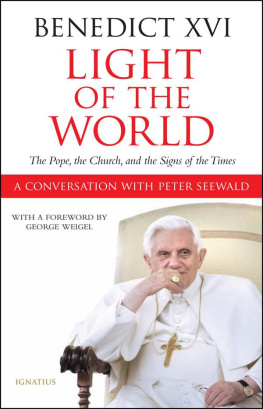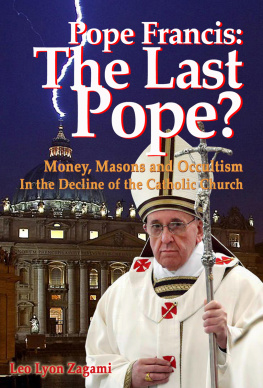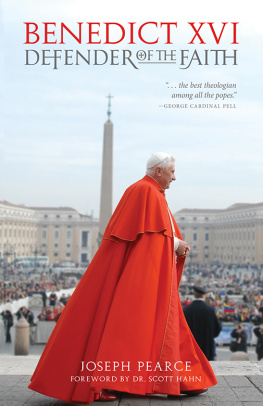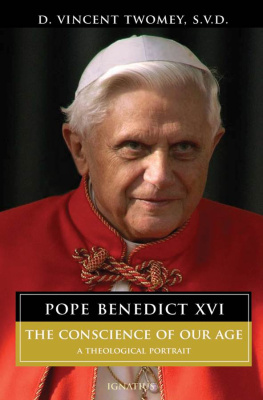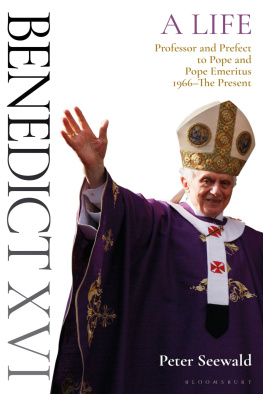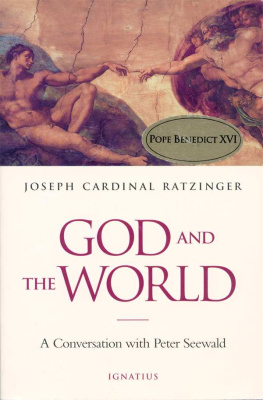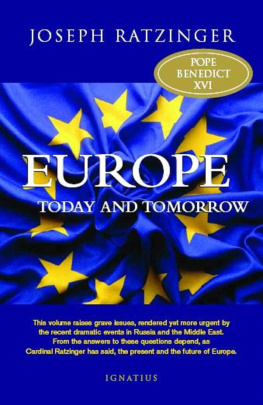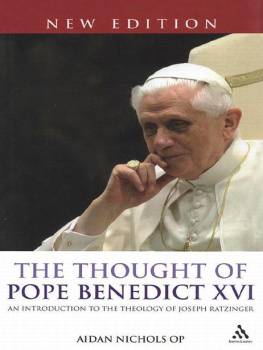Light of the World
Benedict XVI
Light of the World
The Pope, the Church, and the Signs of the Times
A Conversation with Peter Seewald
Translated by
Michael J. Miller and Adrian J. Walker
IGNATIUS PRESS SAN FRANCISCO
Original German edition:
Licht der Welt: Der Papst, die Kirche und die Zeichen der Zeit:
Ein Gesprch mit Peter Seewald
2010 by Libreria Editrice Vaticana, Vatican City
All rights reserved
Preface, chapters 1-7, and the appendix on Benedict XVIs curriculum vitae and chronology translated by Michael J. Miller. Chapters 8-18 translated by Adrian J. Walker.
Cover: Photograph of Pope Benedict XVI: Stefano Spaziani
Front cover design by Roxanne Mei Lum
Back cover design by John Herreid
2010 by Ignatius Press, San Francisco
All rights reserved
ISBN 978-1-58617-606-8
Library of Congress Control Number 2010939358
Printed in the United States of America
God looks down from heaven upon the sons of men ,
to see if there are any that are wise, that seek after God... .
They eat Gods bread ,
But they do not call upon his name .
Psalm 53:3-5
Contents
Part I: SIGNS OF THE TIMES
Part II: THE PONTIFICATE
Part III: WHERE DO WE GO FROM HERE?
Foreword
George Weigel
The Chair of Peter affords its occupant a unique view of the human condition, unlike that offered to any other global figure from any other vantage point.
World political leaders see the flow of history in terms of interests, alliances, and power. Intellectuals of international repute perceive humanity in terms of their philosophical, historical, or scientific theories. Leaders of great commercial enterprises analyze the world in terms of markets to be penetrated. World-renowned entertainers imagine their audiences in terms of the emotions they seek to evoke.
Popes, if they have the wit and the stomach for it, see the whole picturethe entirety of the human drama, in both its nobility and its wickedness. And they see it through the prism of humanitys origins and humanitys ultimate destiny.
It can be a dizzying, even disorienting, view. Over almost two millennia of papal history, some Popes have indeed bent history to their willsor, perhaps more accurately, to the power of their faith; one thinks immediately of John Paul Ils pivotal role in the collapse of European Communism. Other Popes have seemed overwhelmed by the tides of history, their papacies swamped by riptides they were unable to channel or resist. Novelist Morris West once wrote that the Chair of Peter... was a high leap, halfway out of the world and into a vestibule of divinity. The man who wore the Fishermans ring and the triple tiara carried also the sins of the world like a leaden cope on his shoulders. He stood on a lonely pinnacle, alone, with the spread carpet of the nations before him, and above, the naked face of the Almighty. Only a fool would envy him the power and the glory and the terror of such a principality. West exaggerated, as novelists tend to do, but he caught something of the unique perspective on humanity and its pilgrimage through history that the papacy thrusts before a man.
Having worked closely with John Paul II for almost a quarter-century, and having written incisively about the Office of Peter for decades before that, Joseph Ratzinger knew all this when the question was put to him on April 19, 2005, two days after his seventy-eighth birthday: Acceptasne electionem de te canonice factam in Summum Pontificem? [Do you accept your canonical election as Supreme Pontiff?] The world and the Church can be grateful that, once again, Ratzinger put his own plans on holdthis time, permanentlyby saying Yes to that awesome query. For Joseph Ratzinger, Pope Benedict XVI, brings both a clear-eyed view and the courage of convictions born in faith and honed by reason to the papacys unique vantage point on the human race in the first decades of the twenty-first century.
What the Pope sees, and what he discusses with frankness, clarity, and compassion in this stimulating conversation with Peter Seewald, is a world that (to borrow from Lutheran theologian Robert Jenson) has lost its story: a world in which the progress promised by the humanisms of the past three centuries is now gravely threatened by understandings of the human person that reduce our humanity to a congeries of cosmic chemical accidents: a humanity with no intentional origin, no noble destiny, and thus no path to take through history. This is not, it must be emphasized, the cranky view of a man ill at ease in the postmodern world. Rather, as Benedict XVI takes pains to underscore in this conversation, his challenge to postmodernity is one intended to preserve and extend the achievements of modernity, not least in the sphere of political freedomand to do so by encouraging postmodernity to rediscover some ancient truths about itself.
Those truths include the necessary dialogue between faith and reason. Faith devoid of reason risks becoming superstition and blind prejudice. Reason inattentive to faith risks solipsism, self-absorption, detachment from reality. The effects of faith detached from reason are all around us: thus Benedicts urgent challenge to Islam. So are the effects of reason inattentive to faith: thus Benedicts challenge, to a West in cultural disarray, to rediscover the biblical roots of the Western civilizational project. Like John Paul II, Benedict XVI sees both facets of this dual crisis of world civilization clearly; and, again like the predecessor to whom he pays touching tribute in this book, he has put these issues on the table of the worlds conversation as no one else has or can.
Benedict XVI brought to the papacy more than a halfcentury of reflection on the truths of biblical faith and a master teachers capacity to explicate those truths and bring them to bear on contemporary situations in a luminously clear way. I have had the privilege of knowing many men and women of high intelligence, even genius, in my lifetime; I have never known anyone like Benedict XVI, who, when one asks him a question, pauses, thinks carefully, and then answers in complete paragraphsoften in his third, fourth, or fifth language. Peter Seewalds well-crafted questions give Benedict XVI good material with which to work. But it is the remarkably lucid and precise mind of Joseph Ratzinger that makes the papal answers here sing.
Those who had known Joseph Ratzinger in his pre-papal days knew this about him, as they had known him for a man of exquisite manners and a pastors kind heart. Which is to say, those who knew the man knew that the caricature of him in the world pressa caricature created by his ecclesiastical enemies in a particularly nasty exercise of odium theologicum was just that: a caricature, a cartoon, with no tether to the real man. Happily, the world has been able to discover this since April 19, 2005.
Those with eyes to see and ears to hear have discovered a pastor who meets, prays, and weeps with those suffering the aftereffects of being abused by men they thought were their shepherds; and by the victims own testimony, the tears were real, as was the Popes horror and anguish at what his brothers in the priesthood had done and what his brothers in the episcopate had failed to address. Those willing to hear and see have met a world-class intellectual who, in addressing British Catholic schoolchildren, distills sixty years of higher learning into a winsome and compelling catechetical message on how important it is to become a twenty-first-century saint. Those who come to Rome to attend one of Benedict XVIs general audiences have encountered a master catechist, whose command of the Bible, the Fathers, and the theological traditions of Christian West and Christian East is simply unparalleledas is his capacity to explicate what he has learned in ways that virtually everyone can understand and engage.
Next page
